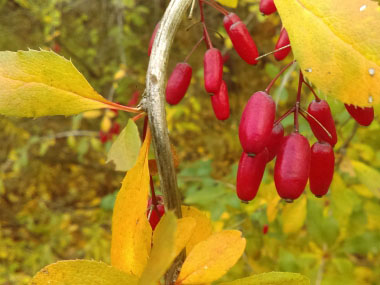








To support our efforts please browse our store (books with medicinal info, etc.).
The common barberry is an upright shrub that is native to Europe and Asia. It was first brought to North America in the 1600s by early New England settlers and escaped from cultivation. It is widely distributed throughout many areas in Canada and the U.S. This shrub has long been used as an herbal remedy for the treatment of many complaints. Interestingly, arching branches which come into contact with the soil can produce new growth. Common barberry looks very similar to the native plant American barberry (B. canadensis), and somewhat similar to invasive Japanese barberry (B. Thunbergii). The leaves of the American barberry are also toothed whereas the Japanese barberry leaves have smooth margins.
Trunk/Bark
This shrub's bark is typically gray bark. The bark of a mature shrub is ridged or plated.
Branches/Twigs
This is a multi branched shrub. Twigs have sharp, needle-like spines in groups of three beneath each leaf cluster. Spines are 1 to 2 cm (0.5 to 0.75”) in length. Winter branch colors ranges from a brown to yellow to gray.
Height
Common barberry can reach heights up to 3m (9') tall (or higher in some cases). It can branch out to 2m (6') wide.
Leaves/Needles
Leaves are simple and have a dull light green color. Leaves measure from 2 to 8cm long with about 16 to 20 teeth per side. Being a deciduous shrub the leaves typically drop in late autumn but many wither and persist throughout the winter. Leaves turn bright shades of red, orange/yellow and/or purple in fall.
Flowers
Its yellow flowers are arranged in 2 to 6 cm (1/2 to 2”) long drooping clusters and appear in early summer. Each flower measures approximately 1 cm (1/2”) long.
Fruit
Mature fruits are small (1cm). These elliptical berries are generally scarlet in color. Each fruit contains 1 to 3 small black seeds. These berries persist on the shrub throughout the winter. It is often referred to as the winter berry shrub.
Habitat
These shrubs tend to prefer forest edges, roadside thickets and in some fields. It prefers sunny locations but is shade tolerant.
Edible Parts
Fruit can be used raw or cooked (although many prefer it cooked). A refreshing lemon-like drink can be made from the fruit. Young leaves can be used as a flavoring. Dried young leaves and shoot tips make a refreshing tea. Fruits are high in vitamins C and K as well as many antioxidants.
Other Name
European Barberry.
Winter Survival Food Handbook

PDF Plant Magazines
Types of Wild Food
Geographic Zones Seasons
Disclaimer
EdibleWildFood.com is informational in nature. While we strive to be 100% accurate, it is solely up to the reader to ensure proper plant identification. Some wild plants are poisonous or can have serious adverse health effects.
We are not health professionals, medical doctors, nor are we nutritionists. It is up to the reader to verify nutritional information and health benefits with qualified professionals for all edible plants listed in this web site. Please click here for more information.
Why Edible Wild Food?
- Food costs are rising
- Free, wild food is readily abundant
- Wild food adds nutrition to your diet
- Wild food can help treat various medical conditions





